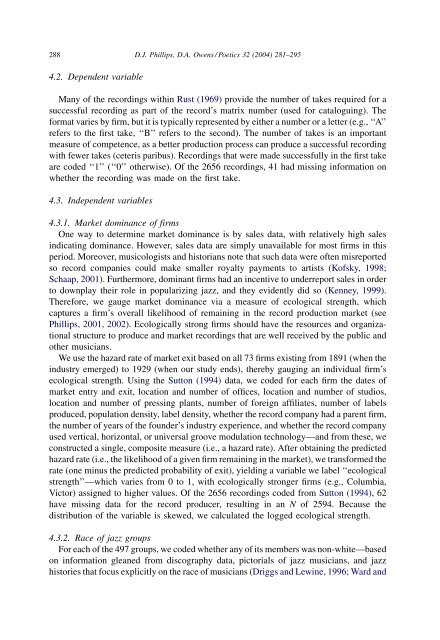Incumbents, innovation, and competence - Cultural Policy Center ...
Incumbents, innovation, and competence - Cultural Policy Center ...
Incumbents, innovation, and competence - Cultural Policy Center ...
You also want an ePaper? Increase the reach of your titles
YUMPU automatically turns print PDFs into web optimized ePapers that Google loves.
288 D.J. Phillips, D.A. Owens / Poetics 32 (2004) 281–295<br />
4.2. Dependent variable<br />
Many of the recordings within Rust (1969) provide the number of takes required for a<br />
successful recording as part of the record’s matrix number (used for cataloguing). The<br />
format varies by firm, but it is typically represented by either a number or a letter (e.g., ‘‘A’’<br />
refers to the first take, ‘‘B’’ refers to the second). The number of takes is an important<br />
measure of <strong>competence</strong>, as a better production process can produce a successful recording<br />
with fewer takes (ceteris paribus). Recordings that were made successfully in the first take<br />
are coded ‘‘1’’ (‘‘0’’ otherwise). Of the 2656 recordings, 41 had missing information on<br />
whether the recording was made on the first take.<br />
4.3. Independent variables<br />
4.3.1. Market dominance of firms<br />
One way to determine market dominance is by sales data, with relatively high sales<br />
indicating dominance. However, sales data are simply unavailable for most firms in this<br />
period. Moreover, musicologists <strong>and</strong> historians note that such data were often misreported<br />
so record companies could make smaller royalty payments to artists (Kofsky, 1998;<br />
Schaap, 2001). Furthermore, dominant firms had an incentive to underreport sales in order<br />
to downplay their role in popularizing jazz, <strong>and</strong> they evidently did so (Kenney, 1999).<br />
Therefore, we gauge market dominance via a measure of ecological strength, which<br />
captures a firm’s overall likelihood of remaining in the record production market (see<br />
Phillips, 2001, 2002). Ecologically strong firms should have the resources <strong>and</strong> organizational<br />
structure to produce <strong>and</strong> market recordings that are well received by the public <strong>and</strong><br />
other musicians.<br />
We use the hazard rate of market exit based on all 73 firms existing from 1891 (when the<br />
industry emerged) to 1929 (when our study ends), thereby gauging an individual firm’s<br />
ecological strength. Using the Sutton (1994) data, we coded for each firm the dates of<br />
market entry <strong>and</strong> exit, location <strong>and</strong> number of offices, location <strong>and</strong> number of studios,<br />
location <strong>and</strong> number of pressing plants, number of foreign affiliates, number of labels<br />
produced, population density, label density, whether the record company had a parent firm,<br />
the number of years of the founder’s industry experience, <strong>and</strong> whether the record company<br />
used vertical, horizontal, or universal groove modulation technology—<strong>and</strong> from these, we<br />
constructed a single, composite measure (i.e., a hazard rate). After obtaining the predicted<br />
hazard rate (i.e., the likelihood of a given firm remaining in the market), we transformed the<br />
rate (one minus the predicted probability of exit), yielding a variable we label ‘‘ecological<br />
strength’’—which varies from 0 to 1, with ecologically stronger firms (e.g., Columbia,<br />
Victor) assigned to higher values. Of the 2656 recordings coded from Sutton (1994), 62<br />
have missing data for the record producer, resulting in an N of 2594. Because the<br />
distribution of the variable is skewed, we calculated the logged ecological strength.<br />
4.3.2. Race of jazz groups<br />
For each of the 497 groups, we coded whether any of its members was non-white—based<br />
on information gleaned from discography data, pictorials of jazz musicians, <strong>and</strong> jazz<br />
histories that focus explicitly on the race of musicians (Driggs <strong>and</strong> Lewine, 1996; Ward <strong>and</strong>









